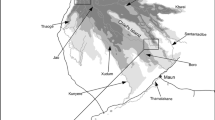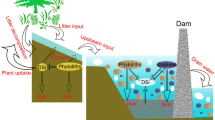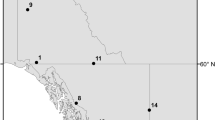Abstract
Amorphous, biogenic Si (ASi) is stored in large amounts in terrestrial ecosystems. The study of terrestrial ASi mobilization remains in the pioneer research stage: most Si budget studies have not included the biogenic amorphous Si stock and fluxes. This hampers our ability to accurately quantify terrestrial mobilization of Si, which is—through ocean carbon burial and CO2 uptake during terrestrial Si weathering—intricately linked to global carbon budgets. We studied detailed concentration and load patterns of dissolved (DSi) and ASi during several high-discharge events in eight first-order river basins. Based on high frequency discharge measurements and concurrent analysis of ASi and DSi concentrations at base flow and during intense precipitation events, we were able to attribute a percentage of yearly ASi and DSi fluxes to both base flow and precipitation event related surface run-off. Our results show ASi and DSi concentrations in upstream river basins to be intricately linked to each other and to discharge, and ASi transport constitutes an important part to the total transport of Si even through first-order river basins (up to 40%). Based on our observations, increased occurrence of peak-discharge events with global climatic changes, and lowered importance of base flow, will coincide with drastic changes in ASi and DSi dynamics in the river continuum. Our work clearly shows ASi dynamics should be incorporated in global Si budgets now, even in low-order small river basins.






Similar content being viewed by others
References
Arnell NW (2003) Relative effects of multi-decadal climatic variability and changes in the mean and variability of climate due to global warming: future streamflows in Britain. J Hydrol 270:195–213
Arnell NW (2004) Climate change and global water resources: SRES emissions and socio economic scenarios. Glob Environ Change 14:31–52
Blecker SW, McCulley RL, Chadwick OA et al (2006) Biologic cycling of silica across a grassland bioclimosequence. Glob Biogeochem Cycles 20:GB3023
Christensen JH, Christensen OB (2003) Severe summertime flooding in Europe. Nature 421:805–806
Clarke J (2003) The occurence and significance of biogenic opal in the regolith. Earth Sci Rev 60:175–194
Cloern JE (2001) Our evolving conceptual model of the coastal eutrophication problem. Mar Ecol Prog Ser 210:223–253
Conley DJ (1997) Riverine contribution of biogenic silica tot the oceanic silica budget. Limnol Oceanogr 42:774–777
Conley DJ (2002) Terrestrial ecosystems and the global biogeochemical silica cycle. Glob Biogeochem Cycles 16:GB1121
Conley DJ, Schelske CL (2001) Biogenic silica. In: Smol JP, Birks HJB, Last WM (eds) Tracking environmental change using lake sediments: biological methods and indicators. Kluwer Academic Press, Dordrecht, pp 281–293
Conley DJ, Schelske CL, Stoermer EF (1993) Modification of the biogeochemical cycle of silica with eutrophication. Mar Ecol Prog Ser 101:179–192
Conley DJ, Likens GE, Buso DC et al (2008) Deforestation causes increased dissolved silicate losses in the Hubbard Brook Experimental Forest. Glob Change Biol 14:2548–2554
Derry LA, Kurtz AC, Ziegler K et al (2005) Biological control of terrestrial silica cycling and export fluxes to watersheds. Nature 433:728–731
Dugdale RC, Wilkerson FP, Minas HJ (1995) The role of a silicate pump in driving new production. Deep Sea Res I 42:697–719
Dürr HH, Meybeck M, Hartmann J (2009) Global spatial distribution of natural riverine silica inputs to the coastal zone. Biogeosciences 6:1345–1401 (Discussions)
Fabres J, Tesi T, Velez J et al (2008) Seasonal and event-controlled export of organic matter from the shelf towards the Gulf of Lions continental slope. Cont Shelf Res 28:1971–1983
Gérard F, Mayer KU, Hodson MJ et al (2008) Modelling the biogeochemical cycle of silicon in soils: application to a temperate forest ecosystem. Geochim Cosmochim Acta 72:741–758
Gouze E, Raimbault P, Garcia N et al (2008) Nutrient and suspended matter discharge by tributaries into the Berre Lagoon (France): the contribution of flood events to the matter budget. C R Geosci 340:233–244
Hermy M, Van Der Veken S, Van Calster H et al (2008) Forest ecosystem assessment, changes in biodiversity and climate change in a densely populated region (Flanders, Belgium). Plant Biosyst 142:623–629
Hodson MJ, White PJ, Mead A, Broadley MR (2005) Phylogenetic variation in the silicon composition of plants. Ann Bot 96:1027–1046
Humborg C, Ittekkot V, Cociasu A et al (1997) Effect of Danube River dam on Black Sea biogeochemistry and ecosystem structure. Nature 386:385–388
Kjellström E (2004) Recent and future signatures of climate change in Europe. Ambio 23:193–198
Kundzewicz ZW, Ulbrich U, Brücher T et al (2005) Summer floods in Central Europe climate change track? Nat Hazards 36:165–189
Middelkoop H, Daamen K, Gellens D, Grabs W, Kwadijk JCJ, Lang H, Parmet B, Schadler B, Schulla J, Wilke K (2001) Impact of climate change on hydrological regimes and water resources management in the rhine basin. Clim Change 49:105–128
Rabosky DL, Sorhannus U (2009) Diversity dynamics of marine planktonic diatoms across the Cenozoic. Nature 457:183–186
Ragueneau O, Tréguer P, Leynaert A et al (2000) A review of the Si cycle in the modern ocean: recent progress and missing gaps in the application of biogenic opal as a paleoproductivity proxy. Glob Planet Change 26:317–365
Riitters K, Wickham J, O’Neill R et al (2000) Global-scale patterns of forest fragmentation. Conserv Ecol 4(3)
Rommens T, Verstraeten G, Bogman P et al (2006) Holocene alluvial sediment storage in a small river catchment in the loess area of central Belgium. Geomorphology 77:187–201
Soetaert K, Middelburg JJ, Heip C et al (2006) Long-term change in dissolved inorganic nutrients in the heterotrophic Scheldt estuary (Belgium, The Netherlands). Limnol Oceanogr 51:409–423
Steegen A, Govers G, Nachtergaele J et al (2000) Sediment export by water from an agricultural catchment in the Loam Belt of central Belgium. Geomorphology 33:25–36
Steegen A, Govers G, Takken I et al (2001) Factors controlling sediment and phosphorus export from two Belgian agricultural catchments. J Environ Qual 30:1249–1258
Street-Perrott AF, Barker PA (2008) Biogenic silica: a neglected component of the coupled global continental biogeochemical cycles of carbon and silicon. Earth Surf Proc Land 33:1436–1457
Struyf E, Conley DJ (2009) Silica: an essential nutrient in wetland biogeochemistry. Front Ecol Environ 7:88–94
Struyf E, Temmerman S, Meire P (2007a) Dynamics of biogenic Si in freshwater tidal marshes: Si regeneration and retention in marsh sediments (Scheldt estuary). Biogeochemistry 82:41–53
Struyf E, Van Damme S, Gribsholt B et al (2007b) Phragmites australis and silica cycling in tidal wetlands. Aquat Bot 87:134–140
Struyf E, Opdekamp W, Backx H et al (2009) Vegetation and proximity to the river control amorphous Si storage in a riparian wetland (Bierbza National Park, Poland). Biogeosciences 6:623–631
Thieu V, Billen G, Garnier J (2009) Nutrient transfers in three contrasting NW European watersheds: the Seine, Somme, and Scheldt rivers. A comparative application of the Seneque/Riverstrahler model. Water Res 43(6):1740
Tréguer P, Pondaven P (2000) Global change—silica control of carbon dioxide. Nature 406:358–359
Tréguer P, Nelson DM, Vanbennekom AJ et al (1995) The silica balance in the world ocean—a reestimate. Science 268:375–379
Trenberth KE, Dai AG, Rasmussen RM et al (2003) The changing character of precipitation. Bull Am Meteorol Soc 84:1205
Van Cappellen P (2003) Biomineralization and global biogeochemical cycles. Rev Miner Geochem 54:357–381
Verlaan PAJ (2000) Marie vs fluvial bottom mud in the Scheldt Estuary. Estuar Coast Shelf Sci 50:627–638
Verstraeten G, Van Rompaey A, Poesen J et al (2003) Evaluating the impact of watershed management scenarios on changes in sediment delivery to rivers? Hydrobiologia 494:153–158
Vorosmarty CJ, Fekete BM, Meybeck M et al (2000) Global system of rivers: its role in organizing continental land mass and defining land-to-ocean linkages. Glob Biogeochem Cycles 14(2):599–621
Walkley A, Black IA (1934) An examination of the Degtjareff method for determining soil organic matter and a proposed modification of the chromic acid titration method. Soil Sci 37:29–38
Walling DE (1999) Linking land use, erosion and sediment yields in river basins. Hydrobiologia 410:223–240
Ward PJ, van Balen RT, Verstraeten G et al (2009) The impact of land use and climate change on late Holocene and future suspended sediment yield of the Meuse catchment. Geomorphology 103:389–400
Willems P (2009) A time series tool to support the multi-criteria performance evaluation of rainfall-runoff models. Environ Model Softw 24:311–321
Woodward J, Foster I (1997) Erosion and suspended sediment transfer in river catchments: environment controls, processes and problems. Geography 82:353–376
Acknowledgments
Eric Struyf would like to thank FWO (Research Foundation Flanders) for personal post doc research funding. We would like to acknowledge Belgian Science Policy (BELSPO: SD/NS/05a) for funding project “LUSi: Land use changes and silica fluxes in the Scheldt river basin” and FWO for funding project “Tracking the biological control on Si mobilization in upland ecosystems” (Project nr. G014609N). Wim Clymans thanks IWT for personal research funding. We would like to thank Tom Van der Spiet and Anne Cools for all analyses.
Author information
Authors and Affiliations
Corresponding author
Rights and permissions
About this article
Cite this article
Smis, A., Van Damme, S., Struyf, E. et al. A trade-off between dissolved and amorphous silica transport during peak flow events (Scheldt river basin, Belgium): impacts of precipitation intensity on terrestrial Si dynamics in strongly cultivated catchments. Biogeochemistry 106, 475–487 (2011). https://doi.org/10.1007/s10533-010-9527-1
Received:
Accepted:
Published:
Issue Date:
DOI: https://doi.org/10.1007/s10533-010-9527-1




